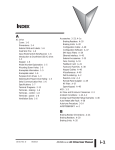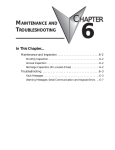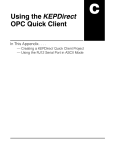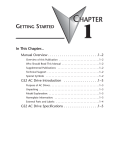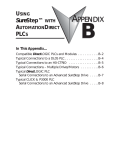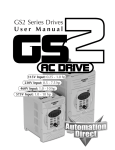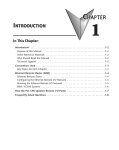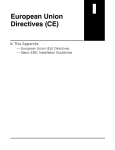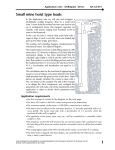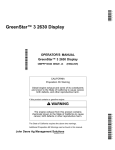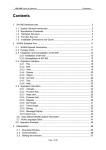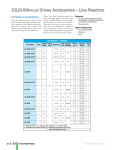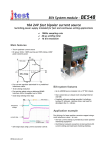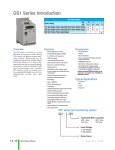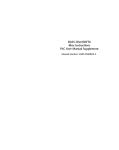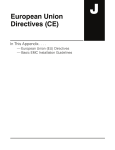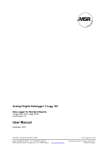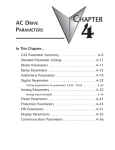Download GS1 Series Introduction
Transcript
GS1 Series Introduction GS1 Series Drives Hp kW 115 Volt Single Phase Input/230 Volt Three Phase Output 230 Volt Single Phase Input/230 Volt Three Phase Output 230 Volt Three Phase Input/Output Motor Rating Overview The GS1 series of AC drives is our most affordable and compact inverter, offering V/Hz control with general purpose application features. These drives can be configured using the built-in digital keypad (which also allows you to set the drive speed, start and stop, and monitor specific parameters) or with the standard RS-485 serial communications port. Standard GS1 features include one analog input, four programmable digital inputs and one programmable normally open relay output. Features .25 0.2 .5 0.4 1 0.75 ✔ ✔ ✔ ✔ ✔ 2 1.5 ✔ Accessories • Simple Volts/Hertz control • Pulse Width Modulation (PWM) • 3 - 10 kHz carrier frequency • IGBT technology • 130% starting torque at 5Hz • 150% rated current for one minute • Electronic overload protection • Stall prevention • Adjustable accel and decel ramps • S-curve settings for acceleration and deceleration • Automatic torque compensation • Automatic slip compensation • DC braking • Built-in EMI filter • Three skip frequencies • Trip history • Integral keypad and speed potentiometer • Programmable jog speed • Three programmable preset speeds • Four programmable digital inputs • One programmable analog input • One programmable relay output • RS-485 Modbus communications up to 19.2K • Optional Ethernet communications • UL/CE listed • AC line reactors • RF filter • Ethernet interface • Four and eight port RS-485 multi-drop termination board • KEPDirect I/O Server • GSoft drive configuration software Detailed descriptions and specifications for the accessories are available in the “GS/DURAPULSE Accessories” section. Typical Applications • Conveyors • Fans • Pumps • Shop tools GS1 series part numbering system GS1 - 2 0P5 Applicable Motor Capacity 0P2: 1/4hp 1P0: 1hp 0P5: 1/2hp 2P0: 2hp Input Voltage 1: 100-120VAC 2: 200-240VAC Series Name 12–14 Drives/Motors/Motion 01737-824600 GS1 Series Specifications PLC Overview DL05/06 PLC 115V/230V CLASS GS1 Series Model Motor Rating GS1-10P2 HP kW Rated Output Capacity (200V) kVA Rated Input Voltage Rated Output Voltage Rated Input Current (A) Rated Output Current (A) Watt Loss 100% (I) Weight: kg (lb) Dimensions (HxWxD) mm (in) GS1-10P5 GS1-20P2 GS1-20P5 GS1-21P0 GS1-22P0 DL105 PLC DL205 PLC 1/4 hp 1/2 hp 1/4 hp 1/2 hp 1hp 2hp 0.2 kW 0.4 kW 0.2 kW 0.4 kW 0.7 kW 1.5 kW 0.6 1.0 0.6 1.0 1.6 2.7 Single phase 100-120 VAC 10%, 50/60 Hz 5% Three phase: 200240 VAC±10%, 50/60 Hz ±5% Single/three phase: 200-240 VAC±10%, 50/60 Hz ±5% Three phase corresponds to double the input voltage Three phase corresponds to the input voltage DL405 PLC Field I/O 6 9 4.9/1.9 6.5/2.7 9.7/5.1 9 1.6 2.5 1.6 2.5 4.2 7.0 19.2 19.2 18.4 26.8 44.6 73 2.10 2.20 2.20 2.20 2.20 2.20 Software C-more HMIs Other HMI 132.0 x 68.0 x128.1 (5.20 x 2.68 x 5.04) Accessories Ethernet Communications module for GS Series Drives (DIN rail mounted) Four port RS-485 multi-drop termination board Eight port RS-485 multi-drop termination board Software OPC Server DL305 PLC AC Drives GS-EDRV Motors GS-RS485-4 GS-RS485-8 Steppers/ Servos GSoft / KEPDirect KEPDirect Motor Controls Proximity Sensors Photo Sensors Limit Switches Encoders Pushbuttons/ Lights Process Relays/ Timers Comm. TB’s & Wiring Power Enclosures Appendix Part Index Drives/Motors/Motion 12–15 GS1 General Specifications General Specifications Control Characteristics Control System Rated Output Frequency Output Frequency Resolution Overload Capacity Torque Characteristics DC Braking Acceleration/Deceleration Time Sinusoidal Pulse Width Modulation, carrier frequency 3kHz - 10kHz Voltage/Frequency Pattern V/F pattern adjustable. Settings available for Constant Torque - low and high starting torque, Variable Torque low and high starting torque, and user configured Stall Prevention Level 20 to 200% or rated current 1.0 to 400.0 Hz limited to 9999 motor rpm 0.1 Hz 150% of rated current for 1 minute Includes auto-torque, auto-slip compensation, starting torque 130% @ 5.0Hz Operation frequency 60-0Hz, 0-30% rated voltage. Start time 0.0-5.0 seconds. Stop time 0.0-25.0 seconds 0.1 to 600 seconds (can be set individually) Operation Specification Frequency Setting Inputs Operation Setting Outputs Keypad Setting by <UP> or <DOWN> buttons or potentiometer External Signal Potentiometer - 5k 0.5W, 0 to 10 VDC (input impedance 47k), 0 to 20 mA / 4 to 20 mA (input impedance 250), Multi-function inputs 1 to 3 (3 steps, JOG, UP/DOWN command), RS485 communication setting Keypad External Signal Setting by <RUN>, <STOP> buttons Multi-Function Input Signal Multi-step selection 0 to 3, Jog, Accel/decel inhibit, First/second accel/decel switch, Counter, PLC operation, External base block (N.C., N.O.) selection Multi-Function Output Signal AC drive operating, Frequency attained, Non zero speed, Base Block, Fault indication, Local/remote indication, PLC operation indication Operating Functions Automatic voltage regulation, S-curve, Over-voltage stall prevention, DC braking, Fault records, Adjustable carried frequency, Starting frequency setting of DC braking, Over-current stall prevention, Momentary power loss restart, Reverse inhibition, Frequency limits, Parameter lock/reset Protective Functions Operator Devices Programming Operator Interface Parameter Monitor Environment Key Functions Enclosure Rating Ambient Operating Temperature Storage Temperature Ambient Humidity Vibration Installation Location Options 12–16 DI1, DI2, DI3, DI4 can be combined to offer various modes of operation, RS485 communication port Drives/Motors/Motion Overcurrent, overvoltage, undervoltage, electronic thermal motor overload, Overheating, Overload, Self testing 5-key, 4-digit, 7-segment LED, 3 status LEDs, potentiometer Parameter values for setup and review, fault codes Master Frequency, Output Frequency, Scaled Output Frequency, Output Voltage, DC Bus Voltage, Output Direction, Trip Event Monitor, Trip History Monitor RUN/STOP, DISPLAY/RESET, PROGRAM/ENTER, <UP>, <DOWN> Protected chassis, IP20 -10° to 40°C (14°F to 104°F) w/o derating -20° to 60 °C (-4°F to 140°F) during short-term transportation period) 0 to 90% RH (non-condensing) 9.8 m/s2(1G), less than 10Hz. 5.88 m/s2 (0.6G) 20 to 50 Hz Altitude 1000m or lower above sea level, keep from corrosive gas, liquid and dust Programming Software (GSOFT) 01737-824600 GS1 Specifications - Installation PLC Overview Understanding the installation requirements for your GS1 drive will help to ensure that it will operate within its environmental and electrical limits. DL05/06 PLC NOTE: Never use only this catalog for installation instructions or operation of equipment; refer to the user manual, GS1-M. DL205 PLC DL105 PLC DL305 PLC Environmental Specifications Protective Structure Ambient Operating Temperature 2 Storage Temperature 3 IP20 Humidity to 90% (no condensation) Vibration 4 5.9 m/S2 (0.6G), 10 to 55 Hz Location DL405 PLC Fan Field I/O 6" 150mm min -10 to 40°C -20 to 60°C Software 2" 50mm min C-more HMIs Other HMI 2" 50mm min Altitude 1,000 m or less, indoors (no corrosive gases or dust) AC Drives Motors 1: Protective structure is based upon EN60529 2: The ambient temperature must be in the range of -10° to 40° C. If the range will be up to 50° C, you will need to set the carrier frequency to 2.1 kHz or less and derate the output current to 80% or less. See our Web site for derating curves. Steppers/ Servos 6" 150mm min Motor Controls 3: The storage temperature refers to the short-term temperature during transport. Proximity Sensors 4: Conforms to the test method specified in JIS CO911 (1984) Photo Sensors Panel Watt-loss Chart GS1 Drive Model At full load GS1-10P2 GS1-10P5 GS1-20P2 GS1-20P5 GS1-21P0 GS1-22P0 19.2 Ground braid copper lugs Input Power Limit Switches To Motor Encoders * FOR PAINTED SUB-PANELS, 19.2 SCRAPE THE PAINT FROM UNDER- 18.4 NEATH THE STAR WASHERS 26.8 Star washers* Panel or single point ground* BEFORE TIGHTENING THEM. 44.6 Pushbuttons/ Lights Process Relays/ Timers 73 Air Flow Warning: AC drives generate a large amount of heat, which may damage the AC drive. Auxiliary cooling methods are typically required in order to not exceed maximum ambient temperatures. Comm. TB’s & Wiring Power Enclosures Appendix Part Index Drives/Motors/Motion 12–17 GS1 Specifications - Terminals Main Circuit Wiring Terminal Description L1, L2, L3 T1, T2, T3 Input power AC drive output Ground Control Circuit Terminals 1 Terminal Symbol Description R1O R1 DI1 DI2 DI3 DI4 AI 1 +10V CM Relay output 1 normally open Relay output 1 common Digital input 1 Digital input 2 Digital input 3 Digital input 4 Analog input Internal power supply (10 mA @ 10 VDC) Common 0 to +10 VDC, 0 to 20 mA, or 4 to 20 mA input represents zero to maximum output frequency. Note: Use twisted-shielded, twisted-pair or shielded-lead wires for the control signal wiring. It is recommended all signal wiring be run in a separate steel conduit. The shield wire should only be connected at the drive. Do not connect shield wire on both ends. 12–18 Drives/Motors/Motion 01737-824600 GS1 Specifications - Basic Wiring Diagram Note: Users MUST connect wiring according to the circuit diagram shown below. (Refer to user manual GS1-M for additional specific wiring information.) DL205 PLC Power Source 3 phase* AC Motor L1 L2 GS1-xxxx T1 IM T2 L3 C-more HMIs Other HMI Grounding resistance less than 0.1 External Fault (N.0) DI1 R1O Multi-function output contacts 120VAC/24VDC @5A 230VAC @2.5A R1 Fault Indication RJ-12 (6P4C) RJ-12 Serial Comm Port DI3 6 1 Jog CM AC Drives Motors Steppers/ Servos Motor Controls DI2 DI4 Common Signal DL405 PLC Software * Use terminals L1 and L2 for 120V, or select any two of the power terminals for 240V single phase models Reverse/Stop DL305 PLC Field I/O T3 Forward/Stop DL05/06 PLC DL105 PLC Note: Refer to the following pages for explanations and information regarding line reactors and RF filters: 12–50, 12–67. 100-120V±10% (50/60Hz ±5%) 200-240V±10% (50/60Hz±5%) PLC Overview Communication Port Proximity Sensors Photo Sensors RS-485 2: GND 3: SG4: SG+ 5: +5V Limit Switches Encoders Pushbuttons/ Lights Process Analog voltage 0-10VDC Potentiometer 3~5k Analog current 0-20mA; 4-20mA +10V 10mA (max) AI Relays/ Timers Comm. TB’s & Wiring CM Power Enclosures Factory default setting Appendix Factory default source of frequency command is via the keypad potentiometer Main circuit (power) terminals Control circuit terminal Shielded leads WARNING: Do not plug a modem or telephone into the GS1 RJ-12 Serial Comm Port, or permanent damage may result. Terminals 2 and 5 should not be used as a power source for your communication connection. Drives/Motors/Motion 12–19 Part Index GS1 Specifications - Dimensions 68.0 (2.68) ) 20 56.0 (2.20) . .5 dia 0. 0( STOP RUN FWD REV 0 PROG ENTER 100 132.0 (5.20) RUN STOP 120.0 (4.72) DISPL RESET V I R1 R1O+ 10V AI DI1 DI2 DI3 DI4 CM 12–20 Drives/Motors/Motion 128.1 (5.04) 123.4 (4.86) 128.1 (5.04) Unit: mm (in) 01737-824600 GS/DURAPULSE Accessories – Overview Accessories part numbering system GS - 23P0 - LR - 3PH Description Code (optional) 1PH: Single phase 3PH: Three phase ENC: Enclosure Blank: For reactor, check specific part # to determine phase Accessory Code BR: Braking resistor FKIT: Fuse Kit FUSE: Replacement fuses for FKIT LR: Line reactor Note: With the exception of the EMI filters and RF filters, each accessory part number begins with GS, followed by the AC Drive rating, and then the relevant accessory code. Following the accessory code, you will find a description code when applicable. The diagram at right shows the accessory part numbering system. Drive Rating (See Drive P/N description) BZL: Bezel CBL: Cable DBU: Dynamic Brake Unit EDRV: Ethernet board FB: Feedback board KPD: Keypad RS: Recommended Standard Drive Series GS: All GS and DURApulse Series Drives GS1: GS1 Series GS2: GS2 Series GS3: DURApulse Series Under 20hp Power Supply Please follow the specific power supply requirements shown in Chapter 1 and the Warning section of the applicable GS or DURAPULSE AC Drives User Manual. From power supply 1 (Refer to page 12–68.) Input fuses protect the AC drive from excessive input current due to line surges, short circuits, and ground faults. They are recommended for all installations and may be required for UL-listed installations. (AutomationDirect fuses are not available for GS1 drives.) Disconnect switch 2 3 Fuses Contactor (Optional) (Refer to the Motor Controls section.) Do not use a contactor or disconnect switch for run/stop control of the AC drive and motor. This will reduce the operating life cycle of the AC drive. Cycling a power circuit switching device while the AC drive is in run mode should be done only in emergency situations. 4 6 5 L1 L2 + (–) T2 7 RF filter (Optional) (Refer to page 12–67.) Braking Resistor (Optional) (Refer to page 12–56.) Dynamic braking allows the AC drive to produce additional braking (stopping) torque. AC drives can typically produce between 15% & 20% braking torque without the addition of any external components. The addition of optional braking may be required for applications that require rapid deceleration or high inertia loads. (Braking resistors are not available for GS1 drives.) 8 Motor Motor grounding terminal 12–46 (Refer to page 12–61.) RF filters reduce the radio frequency interference or noise on the input or output side of the inverter. T3 6 EMI filter (Optional) Input EMI filters reduce electromagnetic interference or noise on the input side of the AC drive. They are required for CE compliance and recommended for installations prone to or sensitive to electromagnetic interference. (Separate EMI filters are not neccessary for GS1 drives.) B1 B2 T1 (Refer to page 12–50.) Input line reactors protect the AC drive from transient overvoltage conditions, typically caused by utility capacitor switching. The input line reactor also reduces the harmonics associated with AC drives. Input line reactors are recommended for all installations. L3 GS and DURAPULSE AC Drive GSx-xxxx Input Line Reactor (Optional) Drives/Motors/Motion Output Line Reactor (Optional) (Refer to page 12–50.) Output line reactors protect the motor insulation against AC drive short circuits and IGBT reflective wave damage, and also “smooth” the motor current waveform, allowing duty” the motor to run cooler. They are recommended for operating “non-iinverter-d motors and when the length of wiring between the AC drive and motor exceeds 75 feet. 01737-824600 GS/DURAPULSE Drives Accessories – Line Reactors 115 Volt Single Phase Input Reactors NOTE: Single phase line reactors should not be installed on the output of the AC Drive. Part Number Rated Impedance Inductance Watt Amps Loss Drive Model and Side / Phase / Volts Drive hp GS-10P2-LR 18 3% 0.80 mH 19 GS1-10P2 (input) / 1ph / 115V GS2-10P2 (input) / 1ph / 115V 0.25 GS-10P5-LR 25 3% 0.50 mH 23 GS1-10P5 (input) / 1ph / 115V GS2-10P5 (input) / 1ph / 115V 0.5 GS-11P0-LR 35 3% 0.40 mH 36 GS2-11P0 (input) / 1ph / 115V 1 230 Volt Single Phase Input Reactors NOTE: Single phase line reactors should not be installed on the output of the AC Drive. Part Number Rated Impedance Inductance Watt Amps Loss Drive Model and Side / Phase / Volts Drive hp GS-20P5-LR-1PH 8 3% 6.50 mH 13 GS1-20P5 (input) / 1ph / 230V GS2-20P5 (input) / 1ph / 230V 0.5 GS-21P0-LR-1PH 12 3% 6.50 mH 13 GS1-21P0 (input) / 1ph / 230V GS2-21P0 (input) / 1ph / 230V 1 GS-22P0-LR-1PH GS-23P0-LR-1PH 18 3% 3.00 mH 25 GS2-22P0 (input) / 1ph / 230V 2 35 3% 2.50 mH 26 GS2-23P0 (input) / 1ph / 230V 3 230 Volt Three Phase Input / Output Reactors Part Number 12–50 Rated Impedance Inductance Watt Amps Loss Drive Model and Side / Phase / Volts Drive hp GS-20P5-LR-3PH 4 3% 6.50 mH 13 GS1-10P5 (output) / 3ph / 230V GS1-20P5 (in/out) / 3ph / 230V GS2-20P5 (in/out) / 3ph / 230V 0.5 GS-21P0-LR-3PH 4 3% 3.00 mH 7 GS1-21P0 (in/out) / 3ph / 230V GS2-21P0 (in/out) / 3ph / 230V GS3-21P0 (in/out) / 3ph / 230V 1 GS-22P0-LR-3PH 8 3% 1.50mH 11 GS1-22P0 (in/out) / 3ph / 230V GS2-22P0 (in/out) / 3ph / 230V GS3-22P0 (in/out) / 3ph / 230V 2 GS-23P0-LR-3PH 12 3% 1.30mH 23 GS2-23P0 (in/out) / 3ph / 230V GS3-23P0 (in/out) / 3ph / 230V 3 GS-25P0-LR 18 3% 0.80mH 19 GS2-25P0 (in/out) / 3ph / 230V GS3-25P0 (in/out) / 3ph / 230V 5 GS-27P5-LR 25 3% 0.50mH 23 GS2-27P5 (in/out) / 3ph / 230V GS3-27P5 (in/out) / 3ph / 230V 7.5 GS-2010-LR GS-2015-LR GS-2020-LR GS-2025-LR GS-2030-LR GS-2040-LR GS-2050-LR 35 3% 0.40mH 36 GS3-2010 (in/out) / 3ph / 230V 10 45 3% 0.30mH 33 GS3-2015 (in/out) / 3ph / 230V 15 55 3% 0.25mH 39 GS3-2020 (in/out) / 3ph / 230V 20 80 3% 0.20mH 88 GS3-2025 (in/out) / 3ph / 230V 25 80 3% 0.20mH 88 GS3-2030 (in/out) / 3ph / 230V 30 130 3% 0.10mH 95 GS3-2040 (in/out) / 3ph / 230V 40 130 3% 0.10mH 95 GS3-2050 (in/out) / 3ph / 230V 50 Drives/Motors/Motion 01737-824600 GS/DURAPULSE Drives Accessories – Line Reactors AC Line Reactor Dimensions (inches) Part Number GS-10P2-LR GS-10P5-LR GS-11P0-LR GS-20P5-LR-1PH GS-20P5-LR-3PH GS-21P0-LR-1PH GS-21P0-LR-3PH GS-22P0-LR-1PH GS-22P0-LR-3PH GS-23P0-LR-1PH GS-23P0-LR-3PH GS-25P0-LR GS-27P5-LR GS-2010-LR GS-2015-LR GS-2020-LR GS-2025-LR GS-2030-LR GS-2040-LR GS-2050-LR GS-41P0-LR GS-42P0-LR GS-43P0-LR GS-45P0-LR GS-47P5-LR GS-4010-LR GS-4015-LR GS-4020-LR GS-4025-LR GS-4030-LR GS-4040-LR GS-4050-LR GS-4060-LR GS-4075-LR GS-4100-LR GS-51P0-LR GS-52P0-LR H W D Mtg D Mtg W Mtg Slot Hole Size Weight (lbs) 4.80 6.00 3.30 2.09 2.00 0.28 x 0.63 7.10 5.7 6.00 3.09 2.09 3.00 0.28 x 0.63 7.00 5.7 6.00 3.34 2.34 3.00 0.28 x 0.63 8.90 3.40 4.40 2.83 1.77 1.44 0.28 x 0.63 2.80 3.40 4.40 2.83 1.77 1.44 0.28 x 0.63 2.80 3.40 4.40 2.83 1.77 1.44 0.28 x 0.63 2.80 3.40 4.40 2.83 1.77 1.44 0.28 x 0.63 2.30 3.40 4.40 2.83 1.77 2.00 0.28 x 0.63 3.10 3.40 4.40 2.83 1.77 2.00 0.28 x 0.63 2.80 4.80 6.00 3.30 2.09 2.00 0.28 x 0.63 7.50 3.40 4.40 2.83 1.77 2.00 0.28 x 0.63 2.90 4.80 6.00 3.30 2.09 2.00 0.28 x 0.63 7.10 5.70 6.00 3.09 2.09 3.00 0.28 x 0.63 7.00 5.70 6.00 3.34 2.34 3.00 0.28 x 0.63 9.00 5.70 6.00 3.84 2.84 3.00 0.28 x 0.63 13.0 5.70 6.00 3.84 2.84 3.00 0.28 x 0.63 12.0 6.88 8.50 4.37 3.12 3.60 0.44 x 1.00 26.0 6.88 8.50 4.37 3.12 3.60 0.44 x 1.00 26.0 6.88 8.50 4.37 3.12 3.00 0.44 x 1.00 27.0 6.88 8.50 4.37 3.12 3.00 0.44 x 1.00 27.0 3.40 4.40 2.83 1.77 1.44 0.28 x 0.63 2.30 3.40 4.40 2.83 1.77 1.44 0.28 x 0.63 2.80 3.40 4.40 3.39 2.39 2.00 0.28 x 0.63 4.30 3.40 4.40 2.83 1.77 2.00 0.28 x 0.63 3.10 4.80 6.00 3.30 2.09 2.00 0.28 x 0.63 7.50 4.80 6.30 3.55 2.34 2.00 0.28 x 0.63 9.10 5.70 6.00 3.34 2.34 3.00 0.28 x 0.63 10.0 5.61 6.90 3.95 2.75 3.00 0.38 x 0.63 17.0 5.61 6.90 3.95 2.75 3.00 0.38 x 0.63 17.0 5.61 6.90 4.45 3.25 3.00 0.38 x 0.63 22.0 6.88 8.50 4.37 3.12 3.00 0.44 x 1.00 26.0 6.88 8.50 4.87 3.62 3.60 0.44 x 1.00 36.0 6.88 8.50 4.87 3.62 3.60 0.44 x 1.00 36.0 8.29 10.50 5.35 3.73 3.60 0.44 x 1.25 52.0 8.29 10.50 5.35 3.73 3.60 0.44 x 1.25 41.0 3.40 4.40 2.83 1.77 1.44 0.28 x 0.63 3 3.40 4.40 2.83 1.77 1.44 0.28 x 0.63 3 Mounting holes W MTG w H x 12–52 Label Drives/Motors/Motion MTG D D 01737-824600 GS/DURAPULSE Drives Accessories – Line Reactors PLC Overview Input side of the drive DL05/06 PLC When installed on the input side of the AC drive, line reactors will reduce line notching, and limit current and voltage spikes and surges from the incoming line. The line reactor will also reduce harmonic distortion from the drive onto the line. Units are installed in front of the AC drive as shown. C2 C1 L3 DL105 PLC T3 B2 B1 T2 L2 DL205 PLC T1 A2 A1 L1 DL305 PLC DL405 PLC Output side of the drive T3 C1 C2 T2 B1 B2 T1 A1 A2 Field I/O When installed on the output side of the drive, line reactors protect the drive from short circuits at the load. Voltage and current waveforms from the drive are enhanced, reducing motor overheating and noise emissions. Note: Single phase line reactors should not be installed on the output of the AC Drive. Use three-phase only. Software C-more HMIs Other HMI AC Drives Multiple drives Motors Individual line reactors are recommended when installing multiple drives on the same power line. Individual line reactors eliminate cross talk between multiple drives and provide isolated protection for each drive for its own specific load. C1 C2 L3 B1 B2 L2 A1 A2 L1 T3 Steppers/ Servos T2 T1 Motor Controls Proximity Sensors Photo Sensors C1 C2 L3 B1 B2 L2 A1 A2 L1 Limit Switches T3 T2 Encoders T1 Pushbuttons/ Lights Process Multiple motors T3 C1 C2 T2 B1 B2 A single reactor can be used when the application calls for multiple motors on the same drive. The reactor is sized based upon the total horsepower of all the motors. Overload relays (not shown) are recommended for use in multi-motor applications. A2 Note: A single reactor should only be used with multiple motors when the motors will always operate simultaneously. T1 A1 TB’s & Wiring Enclosures C1 C2 B1 B2 A1 A2 L2 Appendix T3 T2 T1 Part Index L1 WARNING: Please ensure that terminals B1 and B2 are properly insulated before making any connections to single-phase power. Drives/Motors/Motion Comm. Power Single phase applications Some of the line reactors are listed for use with single-phase input power. Follow the connection diagram to the left. Make sure that terminals B1 and B2 are properly insulated before any connections are made. Relays/ Timers 12–53 GS/DURAPULSE Accessories – RF Filter PLC Overview DL05/06 PLC RF Filter for GS/DURAPULSE AC Drives Part Number Drive Model RF220X00A GSx-xxxx DL105 PLC DL205 PLC Can be used with all series GS/DURAPULSE AC drives DL305 PLC Description DL405 PLC Zero phase reactors, (aka RF noise filters) help reduce radiated noise from the inverter wiring. The wiring must go through the opening to reduce the RF component of the electrical noise. Loop the wires three times (four turns) to attain the full RF filtering effect. For larger wire sizes, place multiple zero-phase reactors (up to four) side by side for a greater filtering effect. These are effective for noise reduction on both the input and output sides of the inverter. Attenuation quality is good in a wide range from AM band to 10 Mhz. Field I/O Software C-more HMIs Other HMI Wiring Method Wind each wire four times around the core, as shown in diagram A to the right. The reactor must be put at inverter side as closely as possible. Motors 36 (1.42) 35 (1.38) 68.5 (2.70) AC Drives 90 (3.54) Steppers/ Servos 25 (0.98) Motor Controls 80 (3.15) Proximity Sensors UNITS: mm (in) If you are unable to wire as above due to wire size or another aspect of your application, put all wires through four cores in series without winding, as in diagram B to the right. Photo Sensors TOP VIEW Limit Switches Encoders A Pushbuttons/ Lights Line L1 T1 L2 T2 L3 T3 Power Process MOTOR Relays/ Timers Comm. TB’s & Wiring B Line Power Power L1 L2 L3 T1 T2 T3 Enclosures MOTOR Appendix Part Index Drives/Motors/Motion 12–67 GS/DURAPULSE Accessories – Ethernet Interface Overview The GS-EDRV Ethernet interface provides a high-performance Ethernet link between a control system and any GS or DURAPULSE AC drive. The GS-EDRV processes signals to and from the drive, mounts on a DIN rail, and connects the drive to an Ethernet hub or PC. It formats signals to conform with the Ethernet standard to the H2-ERM or H4-ERM, KEPDirect EBC I/O server (as shown on the following page), or independent controller with a Modbus TCP/IP driver. This allows for greater connectivity to many control system architectures. An additional feature is the built-in web browser which allows users to configure and control the drive from any web browser via the IP address of the GS-EDRV card. D2-260 with H2-ERM GS-EDRV works with GS1, GS2, and GS3/DURAPULSE drives. GS-EDRV GS-EDRV E-SW05U PLC Overview DL05/06 PLC DL105 PLC DL205 PLC DL305 PLC DL405 PLC Field I/O Software C-more HMIs DURAPULSE Drive DURAPULSE Drive Other HMI AC Drives Note: The GS-EDRV requires an external 24 VDC power supply. Communication Ports Dip Switches Motors Automatic power shut-down Steppers/ Servos The GS series drives have a provision for shutting down control or power to the inverter in the event of a communications time-out. This function can be set up through the drive parameter group 9. Proximity Sensors Motor Controls Photo Sensors Limit Switches Encoders Specifications Part Number GS-EDRV Input Voltage Input Current 10-33 VDC Pushbuttons/ Lights Process LED Indicators 90-135 mA Can be used with all series GS/DURAPULSE AC drives Relays/ Timers Power Terminals Chassis or system ground connection Negative connection (-) or 0VDC Positive connection (+) or +24 VDC Comm. TB’s & Wiring Power Dimensions Enclosures Appendix 2.7" Part Index 1.9" 4.0" units: inches Drives/Motors/Motion 12–71 GS/DURAPULSE Accessories – Software KEPDirect I/O Server Overview The KEPDirect EBC I/O server software is a 32-bit application that provides a way to connect your favorite Windows client software to AUTOMATIONDIRECT Ethernet I/O through our Ethernet base controllers. It provides GS/DURAPULSE series drive support via the GS-EDRV Ethernet interface, as shown in the diagram below. KEPDirect allows the user a direct line into the drive parameter group just like an Ethernet field I/O drop. The user can control or monitor from any OPC/DDE compliant third party software. For a complete description of KEPDirect software features, go to the Software section of this catalog. Several application notes specific to the versatility of this software can be found on our web site at www.automationdirect.com. KEPDirect I/O Server Software Part Number Description PC-KEPEBC-3 Supports up to three GS-EDRV or EBC nodes PC-KEPEBC-7 Supports up to seven GS-EDRV or EBC nodes PC-KEPEBC-8P Supports eight or more GS-EDRV or EBC nodes CMMS and Condition Monitoring of Drives and Hardware Applications Condition monitoring is usually the last part of CMMS (Computer Maintenance Management Software) implementation to be explored. It is expensive and difficult to use. Traditionally, the CMMS companies have used custom built data acquisition (DAQ) boards to monitor systems for values like vibration or temperature. New technologies like KEPDirect, GS/DURAPULSE drives, and Terminator field I/O are perfect matches to allow the user to dispose of expensive proprietary DAQ boards. In addition to the cost savings, the intuitive set-up will reduce implementation. These will become the standard tools that monitor control loop performance on-line and in real time. These tools enable continuous monitoring of control loops, and instant notification of operational deviations as they occur. Using OPC to tie these systems into CMMS provides tracking and automatic evaluation of your soft and hard assets. It also enables easy tracking of true operational and maintenance costs associated with those assets. Personnel can focus on fixing the cause of the problem, and not just the symptom. to next PC-KEPEBC-UPG Upgrade larger package Can be used with all series GS/DURAPULSE AC drives; Requires GS-EDRV Ethernet interface. KEPDirect I/O Server Software Larger Scale Asset Management Applications On a larger scale, such as Asset Management Software, there is too much information to directly link to the software (many of them are OPC/DDE compliant). There must be a buffer of some type. Usually this buffer is a SCADA type package that handles distribution of information gathered by condition monitoring field devices. KEPDirect and Terminator field I/O can connect as easily to the SCADA software as to any OPC compliant software. Major OPC Clients supported • Rockwell Software RSView32® • GE’s Cimplicity® • Iconics’ Genesis32® • Cutler Hammer’s PanelMate PC Pro • Think & Do Live! • Think & Do Studio • Wonderware’s In Touch® and OPCLink® • Intellution’s Fix Dynamics® and OPC Power Tool® • Siemen’s WinCC® • Kepware’s OPC QuickClient • BizWareDirect’s DataNet OPC System Requirements To run KEPDirect I/O Server, your PC must meet the following requirements: • Pentium CPU, 400 Mhz clock speed • Windows 98, NT 4.0 SP5, 2000 or XP • 64 MB free RAM and 10 MB free hard disk space GS-EDRV E-SW05U GS1, GS2, GS3/ DURAPULSE Drives 12–72 Drives/Motors/Motion 01737-824600 GS/DURAPULSE Accessories – Software System Requirements To run GSoft, your PC must meet the following requirements: • Windows 95, 98, Me, NT, 2000 or XP • Internet Explorer 4.0 or higher (for HTML help support) • 24 Mb of available memory • 8Mb hard drive space • Available RS-232 serial port Overview GSoft, the configuration software for the GS/DURAPULSE drives, allows a personal computer to be directly connected to the drives via RS-232 or RS-485 (RS-485 requires FA-ISOCON or user supplied converter). You can perform a variety of functions to allow easy, intuitive, and secure set-up of any application that is required using GSoft. Features • Create new drive configurations using one of three views: • Quick Start - Allows for just the basic set-up to get quick and simple applications up and running ASAP. • Detailed - The complete set-up of all parameters in the drive. • Schematic Views - Set up the drive using the interactive schematic view. Create a printable cad-like drawing at the same time for future documentation and maintenance-friendly activities. GSoft offers three software configuration methods PLC Overview • Upload/download drive configurations. • Edit drive configuration . • Archive/store multiple drive configurations on your PC . • Trend drive operation parameters in real time. • Maintenance keypad will allow the user to commission the drive from the PC, check rotation, and run a basic cycle. • Live PID tuning with active tuning control. Take the difficulty out of PID tuning with a real time trend. • View drive faults. • OPC client with KEPDirect EBC I/O server over the Ethernet with the GS-EDRV option card • Have a large system with KEPDirect already being used to supply information to your SCADA system? Now program online with drive changes. GS/DURAPULSE AC Drive Software Part Number Description GSOFT GS-232CBL configuration software FA-ISOCON RS-232 to RS-422/485 converter with ANTE RS-232 cable Can be used with all series GS/DURAPULSE drives; FA-ISOCON required for GS1 and DURAPULSE drives. DL05/06 PLC DL105 PLC DL205 PLC DL305 PLC DL405 PLC Field I/O Software C-more HMIs Other HMI AC Drives Motors Steppers/ Servos Motor Controls Proximity Sensors Detailed Configuration Photo Sensors The Detailed Configuration method provides AC drive parameter access in a tabbed dialog format. Detailed Configuration can be used for new or existing configurations. Limit Switches Encoders Pushbuttons/ Lights Schematic View Configuration Process The Schematic View Configuration method uses a schematic picture of the AC drive and external connections to guide you through the setup of the AC drive. The Schematic View method can be used for new or existing configurations. Relays/ Timers Comm. TB’s & Wiring Power Quick Start Configuration Enclosures The Quick Start Configuration method guides you through the most commonly used AC drive parameters. Quick Start Configuration may ONLY be used to create a new configuration. Once created and saved, subsequent editing is done using the Detailed or Schematic View methods. Drives/Motors/Motion Appendix Part Index 12–73















